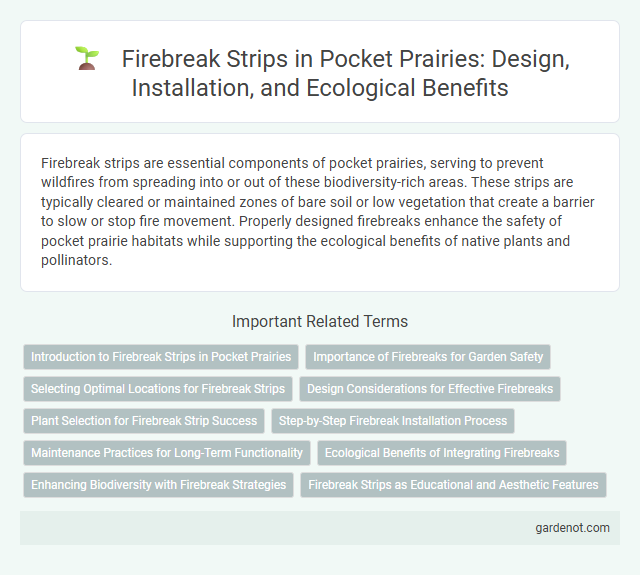Firebreak strips are essential components of pocket prairies, serving to prevent wildfires from spreading into or out of these biodiversity-rich areas. These strips are typically cleared or maintained zones of bare soil or low vegetation that create a barrier to slow or stop fire movement. Properly designed firebreaks enhance the safety of pocket prairie habitats while supporting the ecological benefits of native plants and pollinators.
Introduction to Firebreak Strips in Pocket Prairies
Firebreak strips in pocket prairies serve as strategically placed barriers that reduce the risk of wildfire spread by interrupting continuous vegetation. These strips typically consist of low-growing, less flammable plants or bare soil, creating effective buffers that protect surrounding ecosystems and urban areas. Incorporating firebreak strips enhances the resilience and safety of pocket prairies, promoting sustainable urban green spaces.
Importance of Firebreaks for Garden Safety
Firebreak strips in pocket prairies act as crucial barriers that prevent the rapid spread of wildfires by removing flammable vegetation and creating safe zones. These strategically placed firebreaks enhance garden safety by protecting native plants, wildlife habitats, and nearby properties from fire damage. Effective implementation of firebreaks reduces fire intensity and aids in controlling and containing potential fire outbreaks within prairie landscapes.
Selecting Optimal Locations for Firebreak Strips
Selecting optimal locations for firebreak strips within a pocket prairie involves analyzing vegetation density, slope, and wind patterns to minimize wildfire spread. Positioning firebreaks near areas with high fuel loads, such as dense grass clusters or invasive shrub patches, enhances their effectiveness. Integrating natural barriers like streams or rocky terrain further strengthens firebreak performance while maintaining native biodiversity.
Design Considerations for Effective Firebreaks
Firebreak strips in pocket prairies require careful consideration of width, vegetation type, and maintenance to effectively reduce wildfire spread. Selecting low-flammability, drought-resistant plants and removing excessive brush and dead material help enhance fire resistance. Proper spacing and regular clearing prevent fire from advancing, ensuring the pocket prairie acts as a reliable barrier.
Plant Selection for Firebreak Strip Success
Selecting fire-resistant native grasses such as switchgrass (Panicum virgatum) and buffalograss (Bouteloua dactyloides) enhances the effectiveness of firebreak strips in pocket prairies. Incorporating low-growing, moisture-retentive plants like sedges and certain wildflowers reduces fuel continuity, limiting fire spread. Prioritizing species with high heat tolerance and minimal flammable oils ensures long-term firebreak durability and ecological balance.
Step-by-Step Firebreak Installation Process
Creating a firebreak strip in a pocket prairie involves clearing vegetation down to bare soil or low-growing plants to prevent fire spread. Begin by marking the perimeter where the firebreak will be installed, using tools like a hoe or brush cutter to remove all flammable materials within this boundary. Maintain the strip regularly by clearing debris and controlling regrowth to ensure an effective fire-resistant barrier.
Maintenance Practices for Long-Term Functionality
Maintaining firebreak strips in pocket prairies involves regular mowing or prescribed burning to prevent shrub and tree encroachment, which enhances fire resistance and preserves native grassland ecosystems. Periodic removal of invasive species and debris ensures the strip remains effective as a barrier, reducing wildfire spread and supporting biodiversity. Consistent monitoring and timely repair of erosion or damage help sustain the firebreak's long-term functionality and ecological health.
Ecological Benefits of Integrating Firebreaks
Firebreak strips in pocket prairies significantly enhance biodiversity by creating diverse habitat edges that support various pollinators and small wildlife. These strips reduce the risk of uncontrolled wildfires, preserving native plant species and maintaining ecosystem stability. Integrating firebreaks also improves soil health by minimizing erosion and promoting nutrient retention within the prairie landscape.
Enhancing Biodiversity with Firebreak Strategies
Firebreak strips in pocket prairies serve as critical barriers to control wildfires while promoting habitat diversity by supporting native plant species. Strategically designed firebreaks incorporate multifunctional vegetation that attracts pollinators and beneficial insects, boosting ecosystem resilience. These fire-adapted zones enhance biodiversity by creating microhabitats that sustain a variety of wildlife throughout fire cycles.
Firebreak Strips as Educational and Aesthetic Features
Firebreak strips in pocket prairies serve as crucial safety measures by preventing the spread of wildfires while also offering educational opportunities to observe fire ecology and management practices. These strips create visually appealing contrasts within the prairie landscape, enhancing aesthetic diversity with structured paths or clearings that showcase native plant species and natural patterns. Integrating firebreak strips encourages community engagement and environmental awareness, making them valuable features for both learning and landscape design.
Firebreak strip Infographic

 gardenot.com
gardenot.com